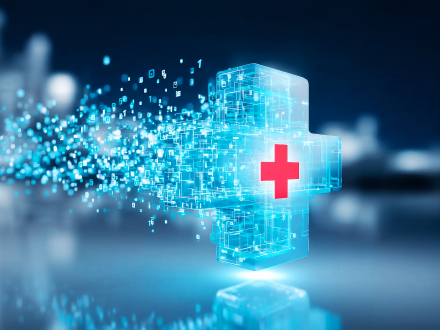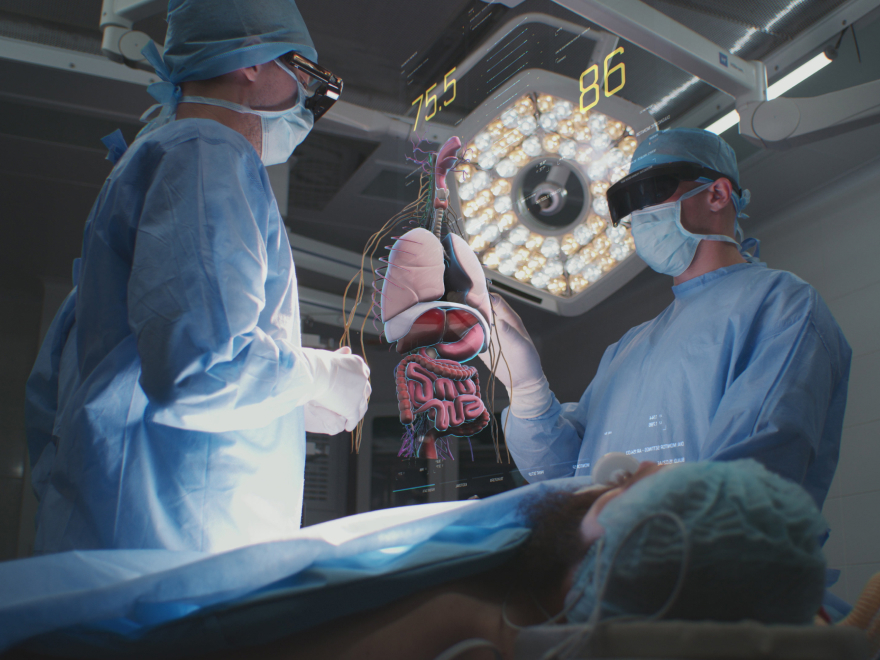Your message has been sent.
We’ll process your request and contact you back as soon as possible.
The form has been successfully submitted.
Please find further information in your mailbox.


Let’s face it, healthcare can be a bit of a guessing game — but what if we had a crystal ball? Predictive analytics is stepping up as that crystal ball, using the power of data to transform healthcare from reactive to proactive: we’re talking everything from spotting health risks before they become major issues to making sure hospitals have the right supplies on hand, to even catching fraudsters in the act. Read on to see how predictive analytics is changing the game in healthcare, one data point at a time.
Predictive analytics in healthcare is all about using statistical algorithms and machine learning techniques to identify the likelihood of future outcomes based on historical data. By analyzing complex patterns in patient records, treatment histories, and demographics, healthcare organizations can identify high-risk patients, with more accuracy than ever before and develop targeted interventions.
This data-driven approach is a game changer for healthcare delivery. At the patient level, it means optimized treatment plans, reduced likelihood of readmissions, and improved disease management. On a broader scale, predictive analytics strengthens population health management, optimizes care quality, and cuts healthcare costs. Ultimately, predictive analytics has the potential to create a more effective and patient-centric healthcare ecosystem that benefits all stakeholders.
The numbers speak for themselves: the healthcare industry is placing a hefty bet on predictive analytics. The global market is expected to skyrocket to a staggering $154.61 billion by 2034, and businesses are clearly recognizing the game-changing potential of this tech. This surge in investment shows that the industry is moving towards proactive, data-driven healthcare solutions, largely doing away with reactive approaches. We’re seeing a big leap from a $14.51 billion market in 2023 to a projected $17.99 billion in 2024: this demonstrates the rapid pace of adoption and the immense growth predicted for the years ahead. There’s no doubt that predictive analytics is poised to bring about a revolution in healthcare.
Let’s move beyond the hype and explore the tangible ways predictive analytics is revolutionizing healthcare, right here.
Predictive analytics in healthcare helps us identify and group patients according to their health risks. This means taking a more proactive approach to healthcare with targeted interventions, optimized resource allocation (e.g., for high-risk individuals), and personalized care plans.

Personalized treatment plans, early disease detection, optimized resource allocation, improved compliance with clinical guidelines, and support for population health management — all made possible thanks to predictive analytics — are changing clinical decision-making.

Predictive analytics changes the way healthcare organizations operate. From resource allocation to inventory management, readmission prevention to equipment maintenance, predictive analytics is making impact. And the best part? These improvements are leading to gains in efficiency and a higher quality of care.

Using data from different sources, predictive analytics helps HCPs identify high-risk populations, predict disease outbreaks, and tailor interventions using a data-driven approach. This allows HCPs to put resources where they're needed most — targeting specific demographics with custom-made programs to address their unique health needs.

Predictive analytics lets HCPs reach out to patients in a personalized way and intervene when needed. It helps spot patients at a more notable risk of losing touch, so medical professionals can give them the support and info they need. This data-driven approach means people can better understand their care and get more involved with their treatment.

Thanks to advanced predictive analytics techniques, HCPs can spot and stop bad actors before they cause any harm. These techniques help identity theft and other fraudulent practices to ensure that patients are only billed for the services they actually receive and safeguarding both patients and healthcare providers from financial fraud.

Predictive analytics is the key ingredient in preventing stockouts and strengthening healthcare supply chains. By forecasting demand and optimizing inventory levels, suppliers can adjust procurement in real time — which, in turn, ensures a reliable and consistent stream of medical supplies and equipment.

Predictive analytics in healthcare helps us identify and group patients according to their health risks. This means taking a more proactive approach to healthcare with targeted interventions, optimized resource allocation (e.g., for high-risk individuals), and personalized care plans.

Personalized treatment plans, early disease detection, optimized resource allocation, improved compliance with clinical guidelines, and support for population health management — all made possible thanks to predictive analytics — are changing clinical decision-making.

Predictive analytics changes the way healthcare organizations operate. From resource allocation to inventory management, readmission prevention to equipment maintenance, predictive analytics is making impact. And the best part? These improvements are leading to gains in efficiency and a higher quality of care.

Using data from different sources, predictive analytics helps HCPs identify high-risk populations, predict disease outbreaks, and tailor interventions using a data-driven approach. This allows HCPs to put resources where they're needed most — targeting specific demographics with custom-made programs to address their unique health needs.

Predictive analytics lets HCPs reach out to patients in a personalized way and intervene when needed. It helps spot patients at a more notable risk of losing touch, so medical professionals can give them the support and info they need. This data-driven approach means people can better understand their care and get more involved with their treatment.

Thanks to advanced predictive analytics techniques, HCPs can spot and stop bad actors before they cause any harm. These techniques help identity theft and other fraudulent practices to ensure that patients are only billed for the services they actually receive and safeguarding both patients and healthcare providers from financial fraud.

Predictive analytics is the key ingredient in preventing stockouts and strengthening healthcare supply chains. By forecasting demand and optimizing inventory levels, suppliers can adjust procurement in real time — which, in turn, ensures a reliable and consistent stream of medical supplies and equipment.

“Predictive analytics in healthcare is even more than giving doctors a crystal ball. It’s about precision, not guesswork, allowing medical professionals to personalize care and optimize resources. This tech doesn’t just improve patient outcomes; it completely transforms how the care sector operates by anticipating needs and preventing problems long before they arise. It’s a game-changer in proactive healthcare.”

Aleh Yafimau
Delivery Manager at Innowise
This section explores how healthcare institutions can fully embrace and take advantage of predictive analytics — from making sure patients get the right treatment to streamlining clinical workflows and making better-informed strategic decisions. Find out how these tools are bringing a new era of data-driven healthcare to life.
These are central hubs for healthcare data, integrating information from EHRs, claims databases, wearables, and other sources. These platforms use advanced analytics and machine learning to identify trends, anticipate future events, and provide insights for stakeholders. Natural language processing can help predict future events by finding useful information in unstructured clinical notes. However, data governance and privacy are important for using these platforms responsibly.
Powered by deep learning, these tools can analyze medical images like X-rays, CT scans, and MRIs with increasing accuracy. Recent studies have shown promising results in areas like cancer detection, diabetic retinopathy diagnosis, and identifying cardiovascular abnormalities — often exceeding human performance in specific tasks. These tools are increasingly used for triage in radiology, prioritizing urgent cases and improving workflow efficiency. It’s worth noting that tools are not designed to replace clinicians, but to support them.
These systems are crucial for managing hospital overcrowding and bed allocation. By accurately predicting factors like emergency room admissions, patient discharge times, and resource utilization, hospitals can optimize staffing levels, reduce wait times, and enhance overall operational efficiency. Plus, these systems are now incorporating real-time data from IoT devices to provide even more accurate predictions and optimize resource allocation dynamically.
Pharmacogenomics is a key use of these platforms, analyzing how an individual’s genetic makeup influences their response to medications. This allows for personalized drug selection and dosage optimization — leading to improved treatment outcomes and reduced adverse drug events. For a more comprehensive approach, these platforms are now expanding beyond pharmacogenomics to include other ‘omics’ data — including proteomics or metabolomics.
Chronic disease management is a great example of a situation in which this software is a winner. By identifying patients at high risk of complications or hospitalization, healthcare providers can proactively take action, coordinate care plans, and encourage medication adherence — ultimately reducing healthcare costs and improving patient outcomes. In order to provide a more holistic, 360-degree view of patient risk, these systems are also increasingly incorporating social determinants of health data.
When linked with EHR systems, clinical decision support systems (CDSS) can give doctors real-time alerts and advice right when they need it. Think of it as having a digital assistant who can flag potential drug interactions, suggest appropriate diagnostic tests based on symptoms, and recommend evidence-based treatment guidelines — all to help clinicians make better-informed decisions on the spot. Modern CDSS are also starting to incorporate the latestAI techniques — such as reinforcement learning — that fine-tunes their recommendations based on past outcomes.
These systems analyze massive amounts of claims data to spot any unusual patterns or catch any irregularities. By using machine learning, they can flag claims that might be fraudulent for further investigation — saving healthcare payers millions of dollars a year and keeping the system fair and accurate. These systems also help to detect improper coding and billing errors, making sure everything’s above board.
These tools use predictive models to zero in on at-risk populations and tweak their public health interventions accordingly. For example, they can predict which areas have a high likelihood of disease outbreaks, enabling targeted vaccination campaigns or resource allocation to mitigate potential public health crises. Additionally, they can personalize patient communication — improving adherence to preventive screenings and promoting healthy behaviors.
Making the leap to data-driven healthcare can be daunting — but it doesn’t have to be. At Innowise, we pave the way for a smooth transition and deliver real results. We go beyond software installation: we give your team the know-how and the tools to unlock the full potential of your data.
Extracting actionable insights from complex healthcare data is the cornerstone of effective predictive analytics. Our data science experts are ready to dig out hidden patterns, build custom predictive models, and deliver concrete, data-driven intelligence to guide your big decisions.

Our team has years of experience in designing custom solution architectures that fit each client's unique processes, data infrastructure, and goals. Our approach makes sure that our systems work with what you've already got, so you can get more out of your predictive analytics, maximize value, and see real results.

We’re here for you every step of the way — from setting up your system and transferring data to training your team and offering all-in-one support throughout the launch. We'll make sure the switch to your new predictive analytics platform is as stress-free and smooth as possible.

Our experts make it easy to move data from your current systems to your new predictive analytics platform — keeping things running smoothly while giving you access to the data you need to make decisions. By making integration simple, we help our clients get the most out of predictive analytics and turn their data into tangible assets.

We offer ongoing support and maintenance services to keep your predictive analytics solution running at its best. Our team is available to address technical concerns, answer questions, and provide guidance on maximizing your investment — not to mention keeping your system up-to-date with the latest feature and security updates.

Extracting actionable insights from complex healthcare data is the cornerstone of effective predictive analytics. Our data science experts are ready to dig out hidden patterns, build custom predictive models, and deliver concrete, data-driven intelligence to guide your big decisions.

Our team has years of experience in designing custom solution architectures that fit each client's unique processes, data infrastructure, and goals. Our approach makes sure that our systems work with what you've already got, so you can get more out of your predictive analytics, maximize value, and see real results.

We’re here for you every step of the way — from setting up your system and transferring data to training your team and offering all-in-one support throughout the launch. We'll make sure the switch to your new predictive analytics platform is as stress-free and smooth as possible.

Our experts make it easy to move data from your current systems to your new predictive analytics platform — keeping things running smoothly while giving you access to the data you need to make decisions. By making integration simple, we help our clients get the most out of predictive analytics and turn their data into tangible assets.

We offer ongoing support and maintenance services to keep your predictive analytics solution running at its best. Our team is available to address technical concerns, answer questions, and provide guidance on maximizing your investment — not to mention keeping your system up-to-date with the latest feature and security updates.

Discover how you can take your healthcare analytics up a level
Predictive analytics in healthcare offers a multitude of benefits that enhance patient care, improve operational efficiency, and reduce costs. Here’s a detailed breakdown of these advantages.
By factoring in medication adherence, comorbidities, and more, predictive models flag patients at high risk of developing conditions like diabetes. This paves the way for preventive measures or treatments to be administered fast — potentially saving lives.
Predictive analytics makes precision medicine possible by analyzing genomic data, biomarkers, and treatment outcomes. In oncology, for example, predictive models help determine which patients are more likely to respond to specific chemotherapy regimens — reducing unnecessary treatments and the side effects that come with them.
Predictive models are very useful for detecting early signs of patient deterioration. The MEWS (Modified Early Warning Score) system uses vital signs data to predict which patients are likely to require intensive care within 24 hours, allowing for well-timed interventions.
For conditions like diabetes, predictive analytics can help forecast blood glucose levels based on factors such as what a patient eats, how much they exercise, and their current medication routine. This means patients receive more accurate insulin doses and better lifestyle advice.
Advanced technology augments human judgment, processing information faster and more accurately. It’s a backup plan that keeps doctors safe from mistakes when prescribing medication and helps spot potential issues with allergies, sensitivities, and double-dosing.
Personalized treatments, when supported by predictive analytics, have been shown to significantly reduce the cost of care. A study by JAMA Network found that personalized treatment plans led to a 35% reduction in adverse patient outcomes — which, in turn, resulted in fewer hospital readmissions, a higher prevention of adverse events, and better resource allocation.
Bringing predictive analytics to healthcare systems presents a number of specific challenges that require thoughtful solutions. At Innowise, we’re dedicated to helping our clients overcome these barriers by employing state-of-the-art tools and strategies tailored exclusively to the healthcare.
Contact us today to explore our tailored solutions.
Predictive analytics is set to fundamentally change the way healthcare institutions manage and deliver their services. With advancements in machine learning and artificial intelligence on the horizon, they’ll be able to analyze increasingly complex and large data sets and more accurate predictions and personalized interventions.
The integration of genomics and predictive analytics will be critical to understanding the genetic factors that influence disease. This will pave the way for personalized treatment plans based on an individual’s genetic makeup.
Real-time data from wearable technology will help healthcare providers to move beyond predicting future risks to identifying impending health events. Imagine a future where a heart attack or diabetic episode can be anticipated and potentially prevented — sounds pretty good, right?
Beyond individual patient care, predictive analytics will play a critical role in public health. Based on analysis of data from multiple sources, outbreaks and epidemics can be detected earlier — leading to faster response times and more efficient impact mitigation. In addition to this, governments can use predictive models to simulate the impact of health policies for more informed decisions about resource allocation and public health interventions.
The combination of these different factors paints a future in which predictive analytics is an integral part of a more proactive, personalized, and effective healthcare system.

The integration of predictive analytics is moving the focus in healthcare from reactive intervention to proactive, personalized medicine. By anticipating potential health risks, providers can act before minor issues have the chance to become serious problems — improving patient outcomes and optimizing healthcare resources.
This data-driven approach supports personalized medicine — think customized treatment plans based on individual patient profiles and genetic predispositions. This targeted approach not only improves the effectiveness of care but also means physicians get the most out of their resources by minimizing unnecessary interventions.
That being said, it’s no surprise that ethical considerations related to privacy and security ought to be carefully addressed. As we continue to adopt predictive analytics into our workflows, it’s essential for patient privacy to remain a top priority and make sure responsible data handling practices are carried out. Healthcare professionals must be equipped with the knowledge and tools they need to interpret and use these predictive insights — maximizing benefits for both individual patients and the care system as a whole.
Predictive analytics draws from a diverse spectrum of data types: from structured data such as patient demographics and lab results to unstructured data like doctor's notes and medical images. Time-series data reveals trends, transactional data tracks patient flow, and geospatial data maps disease outbreaks, while behavioral data offers unique, evidence-based insights into patient actions. Combining these data types provides a comprehensive, all-in-one view of a patient’s health status.
It’s a no-brainer that healthcare organizations should prioritize data privacy and security. Encrypting data, controlling access, and anonymizing information are non-negotiable — as is full compliance with regulations like HIPAA and GDPR. Regular staff training, security audits, and collaboration with IT experts offer a big help when it comes to safeguarding patient privacy while leveraging predictive analytics.
Machine learning and AI are fundamental to modern predictive analytics. They possess superior capabilities of processing vast healthcare datasets, uncovering hidden patterns, and continuously learning from new information to improve predictions. This enables more accurate risk assessments, personalized interventions, and efficient resource allocation.
While predictive analytics has transformative potential across various domains, its application should be guided by careful consideration of a number of ethical principles — including but not limited to privacy, bias, consent, and accountability, as well as transparency, impact on employment, security risks, and manipulation potential. It’s also important to bear in mind aspects of regulatory compliance as well as long-term societal effects.













Your message has been sent.
We’ll process your request and contact you back as soon as possible.

By signing up you agree to our Privacy Policy, including the use of cookies and transfer of your personal information.